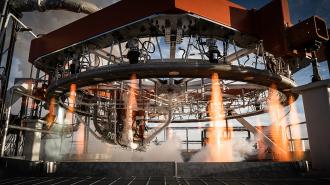Washington-based startup Stoke Space Technologies is on a mission to create the world’s first fully reusable rocket — by completely reimagining what a rocket engine looks like.
The standard: After a rocket delivers its payload to space, it typically either crash-lands in the ocean, burns up in the atmosphere, or becomes space junk. That means its operator needs to cover the full cost of the rocket in each launch, along with fuel and other expenses.
Rockets aren’t cheap, so militaries, governments, and businesses with really deep pockets have traditionally been the only ones who could afford to pay for these expensive launches, leaving space inaccessible to everyone else — but that’s starting to change thanks to reusable rockets.
No one has flown a fully reusable rocket yet — even SpaceX only recovers the lower stage of Falcon 9.
Reusable rockets: Because a reusable rocket can fly more than once, its cost can be spread across multiple launches. The more times the rocket flies, the cheaper each launch can be, and cheaper launches make space accessible to more researchers, startups, and tourists.
Rocket launches are still more expensive than they have to be, though, and part of the reason is that no one has flown a fully reusable rocket yet — even SpaceX only recovers the lower stage of its Falcon 9 rocket, letting the upper stage burn up in Earth’s atmosphere.
The time required to inspect and refurbish the parts of a rocket that are recovered also limits how often it can fly. The longer it takes to check out the reused parts, the fewer flights, which can increase competition for scheduled launches, driving up their costs.
“We’re still in ‘reusability 1.0’ and it’s time to go to ‘reusability 2.0.'”
Andy Lapsa
Stoke Space: In 2019, aerospace veterans Andy Lapsa and Tom Feldman founded Stoke Space Technologies with the goal of building a fully reusable rocket that could be refurbished and reflown within 24 hours — the turnaround on a Falcon 9, for comparison, is 9 days.
“We’re still in ‘reusability 1.0’ and it’s time to go to ‘reusability 2.0,’” Lapsa told Space News in February 2021.
“In reusability 1.0, these are things that can be reused but they’re not necessarily things that are operationally efficient to reuse,” he continued. “Reusability 2.0 is the next step, where we’re now focused on operations and quick turnaround.”
How it works: Traditional upper stage rockets have one engine with a large nozzle. Because every extra ounce of weight increases the amount of fuel needed to launch it, this nozzle is designed to be as light as possible — which typically means it’s also fragile.
That’s not usually a problem because the nozzle isn’t exposed until the upper stage separates from the lower stage in the vacuum of space. However, if the upper stage tried to reenter Earth’s atmosphere, the fragile nozzle would need to be protected — likely by heat shields that add to its weight.
Stoke Space thinks the solution to this problem is a completely different upper stage engine design, one with 30 smaller thrusters in a ring formation. It’s already built one of these engines and began test-firing it in September.
“It is new. It’s different. It’s weird. It’s original.”
Andy Lapsa
Looking ahead: After more engine testing, Stoke Space will move on to “hop” tests of its reusable rocket, when it will launch an upper stage prototype hundreds of feet into the air and then attempt to control its return to Earth.
“This is kind of a final proof point of this architecture,” Lapsa told Ars Technica. “It is new. It’s different. It’s weird. It’s original. There were a lot of questions that we had about how this thing is going to work. But we’ve already mitigated a lot of risk.”
The big picture: Stoke Space has some momentum — it’s raised more than $100 million, with Bill Gates’ Breakthrough Energy Ventures leading a $65 million round at the end of 2021 — but it’s still too soon to predict its likelihood of success.
Stoke Space isn’t the only startup working to usher in reusability 2.0, though — LA-based startup Relativity Space expects to have a fully reusable rocket ready for launch as soon as 2024.
SpaceX’s Starship rocket, meanwhile, is fully reusable and expected to reach orbit before the end of 2022. It’s designed to fly repeatedly with an incredibly fast turnaround — CEO Elon Musk has said he anticipates it eventually launching as frequently as three times a day, potentially making space more accessible than ever before.
We’d love to hear from you! If you have a comment about this article or if you have a tip for a future Freethink story, please email us at [email protected].






